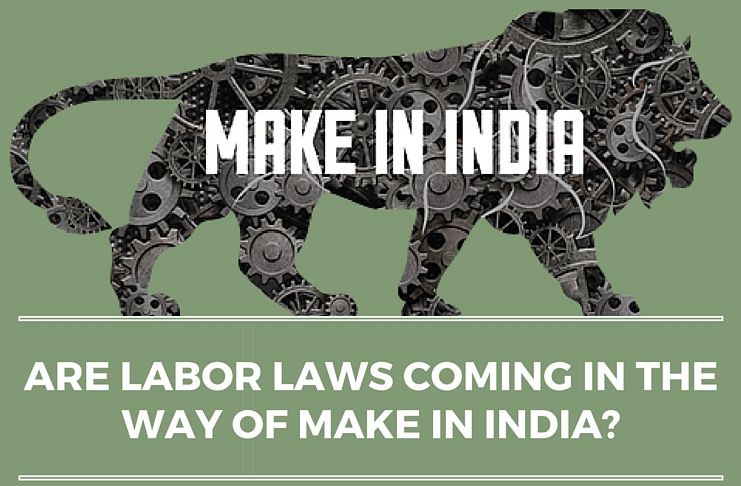Make in India : Is it stumbling over our labour laws?
[dropcap color=”#008040″ boxed=”yes” boxed_radius=”8px” class=”” id=””]F[/dropcap]or setting up a manufacturing base in India, Investors are looking a change in existing Indian labor laws and adjust the same to existing market conditions. Currently, Indian labor laws are considered to be most restrictive.
There are two provisions of Industrial Disputes Act of 1947 which are in the way of workforce adjustments.
One being, Chapter VB of the Industrial Disputes Act of 1947 requires prior approval of the appropriate government before resorting to any layoff, retrenchment or closure of establishments employing 100 or more workers.
Currently amended draft law on Industrial Relations is in circulations which seek to raise the threshold to establishments employing 300 or more workers. However this is still in progress.
[dropcap color=”#008040″ boxed=”yes” boxed_radius=”8px” class=”” id=””]A[/dropcap]nother major contentious provision is Section 9A of the Act which mandates 21 days’ notice before affecting any change in established conditions of service of any employee, including any change necessitated by “rationalization, standardization or improvement of plant or technique”. This is anathema for investors, particularly in this age of fast changing technologies and manufacturing processes.
Contract labour is yet another major area of concern. Investors would surely want to know if engaging workers on temporary contracts would run afoul of the law. The Contract Labour (Regulation and Abolition) Act, 1970, as the name suggests, is enforced to regulate the practice and abolish it in certain cases.
In other words, the practice is not prohibited. Engaging contract workers for temporary, intermittent or seasonal work is allowed but using them for work of perennial nature violates the letter and spirit of the law.
[dropcap color=”#008040″ boxed=”yes” boxed_radius=”8px” class=”” id=””]W[/dropcap]hy would investors want to engage workers on temporary contracts in the first place? To meet surges in demand for goods and services requiring urgent workforce adjustments. Immediate deployment of regular workers is not always feasible and pruning them alongside falling demand often meets legal obstacles. Moreover, regular workers are increasingly becoming less productive and more expensive.
The central government has yet to initiate any action in this area. Rajasthan has taken the early lead, raising the threshold for applicability of the law to cover industries or contractors engaging 40 or more contract workers, up from the original 20. Other state governments are expected to follow suit. The move has been welcomed by employers and criticized as anti-worker by trade unions.
But changing the applicability clause is like nibbling at the edges. Plunging into the core, the status of temporary workers must be redefined and extended beyond the present limit of 240 days in a year. That should take care of persistent demands by the traditional trade union movement for regularization of all contract workers.
On this aspect, the experiment by India’s largest carmaker is innovative and instructive. In 2012, Maruti introduced a new category of directly recruited temporary workers, substantially reducing the role of intermediaries. It has appreciably narrowed the gap in emoluments and allowances between regular and contract workers, which is the main bone of contention.
Temporary workers get on-the-job training as apprentices and become eligible for regular appointment in due course. Maruti pays such workers a stipend for the period they must wait out for regular appointment. This also promotes a sense of belonging and solidarity with the company. It is the habit of institutions to give birth to loyalties. The policy has worked well and has brought industrial peace to what was a volatile workplace.
The big question is: How soon can the central government bring about meaningful changes in the existing laws to facilitate quick workforce adjustments?
For investors, this is the major sticking point. Can the government drive the labour reforms agenda through the legislative route and achieve desirable outcomes?
Given the present party alignments in the Rajya Sabha, this is like building castles in the air. Alternatively, can executive orders be employed to achieve the desired results? Some quick thinking is needed in this direction, followed by swift action.
[dropcap color=”#008040″ boxed=”yes” boxed_radius=”8px” class=”” id=””]A[/dropcap]s the reforms package unfolds, pragmatic solutions will have to be discovered to assure investors that their business interests would not suffer by mindless application of the law, while taking care to ensure that workers’ interests are not compromised.
Labour reforms are critical to the “Make in India” campaign. Investors have been waiting with anticipation. Brand India cannot afford to disappoint.
About Make in India
Here is an excellent post on Make in India.
Notes:
1. IANS
- Pentagon cancels aid to Pakistan over record on militants - September 2, 2018
- The curious case of Tamil Nadu’s opposition to NEET - September 4, 2017
- If 2.6 Billion People Go To War: India vs. China - July 22, 2017











